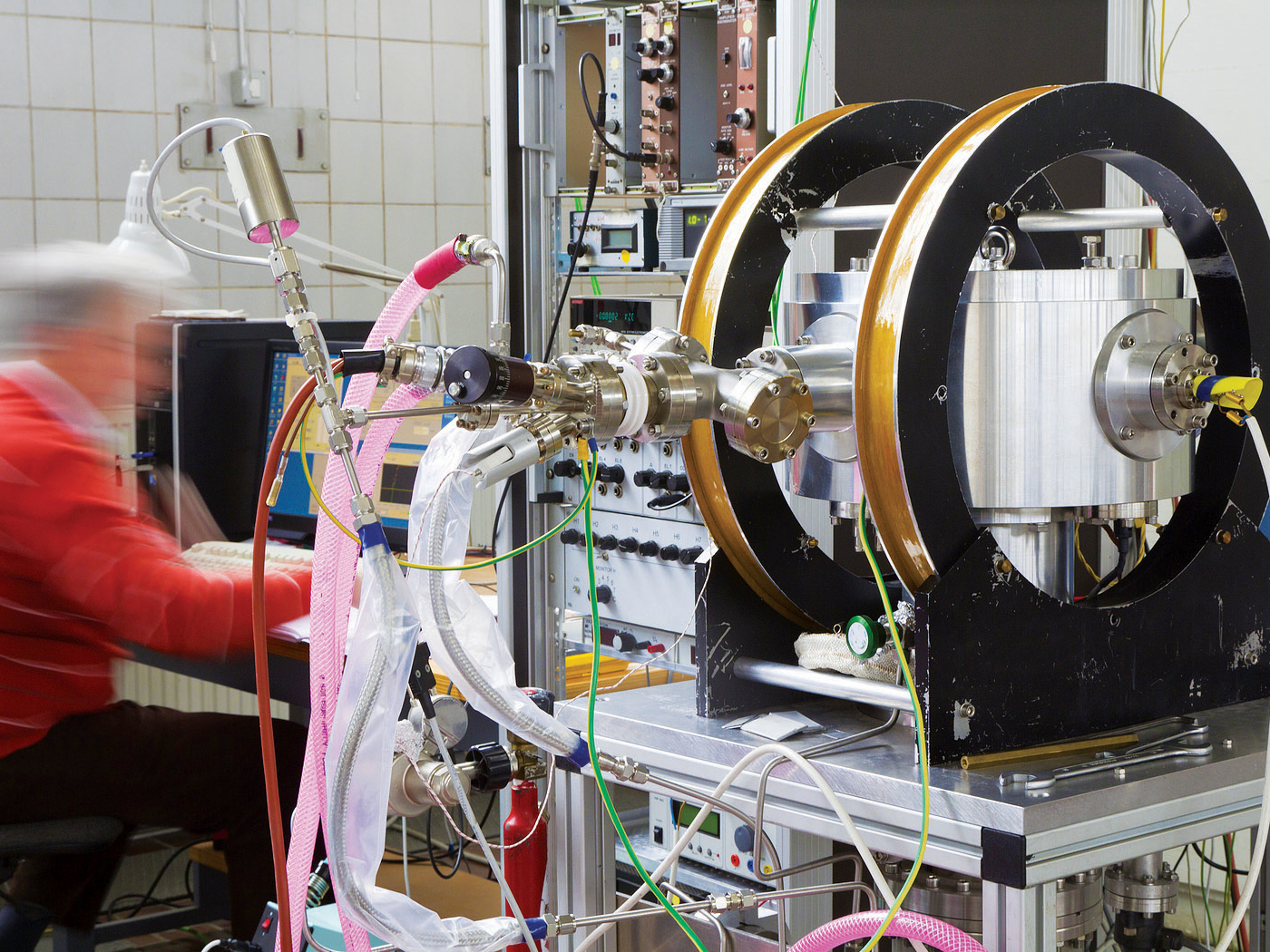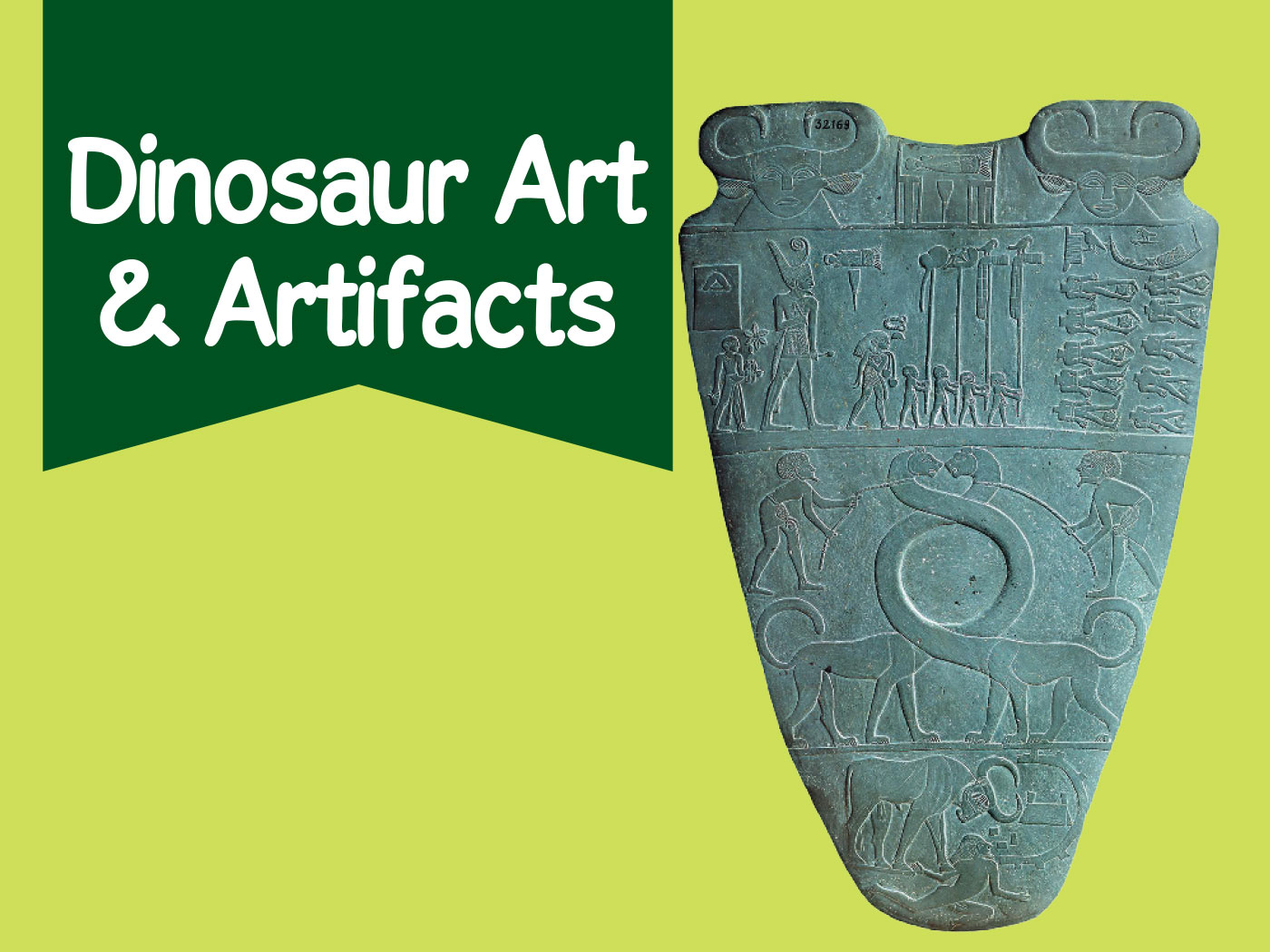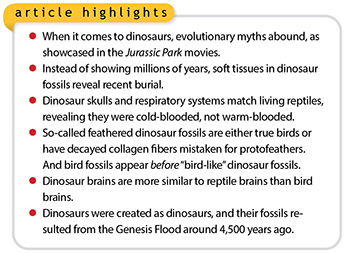 Dinosaurs capture the public imagination like no other creatures. The extreme popularity of the Jurassic Park movie series over the past three decades highlights this interest. But the Jurassic Park movies not only pander to people’s fascination with dinosaurs, they also reveal trends in evolutionary speculation that have no factual basis.1
Dinosaurs capture the public imagination like no other creatures. The extreme popularity of the Jurassic Park movie series over the past three decades highlights this interest. But the Jurassic Park movies not only pander to people’s fascination with dinosaurs, they also reveal trends in evolutionary speculation that have no factual basis.1
It’s bad enough we’re told dinosaurs lived millions of years ago, despite the fact numerous fossil bones contain intact soft tissues and proteins.2 Now we’re also bombarded with unsubstantiated claims that dinosaurs were warm-blooded, had feathers and brains like birds, and were able to live in cold, snowy environments. What is the truth regarding these dinosaur claims?
Myth One: Dinosaurs Evolved Millions of Years Ago
According to the evolutionary story, the first official dinosaurs didn’t show up until the Upper Triassic system, conventionally dated at approximately 230 million years ago.3 This scenario is built on the evolutionary idea that Earth’s sedimentary rock layers were laid down slowly and progressively over a period of about 540 million years. However, ICR scientists have shown that the various megasequences (large rock-layer units) of water-borne strata (sandstone, limestone, and shale) that form the geologic column were deposited about 4,500 years ago in a year-long global catastrophe known as the Genesis Flood.4
The Flood was a progressive event that began with the burial of marine creatures in the first three megasequences. The deposition of these strata took place the first 40 days of the Flood and includes the Cambrian through the Devonian system rocks. Next, the burial of land animals began as tsunami-like waves fueled by new tectonic plate formation pushed the water higher onto the edges of the lowland regions.5-10
This is why we see fossils like tropical coastal vegetation, lizards, and dragonflies in the Absaroka Megasequence (Carboniferous system) as the floodwaters first slammed into the land.10 As new ocean crust was formed, water was pushed higher, inundating the large lizards and other reptiles found in the overlying Permian system.11 These reptiles were as large as many dinosaurs.5 In the Triassic system layers higher in the Absaroka Megasequence, we find various dinosaurs. Different types keep showing up through the overlying Zuni Megasequence rocks, which include the Jurassic and Cretaceous system rock layers.3,12,13
Each fundamental dinosaur kind shows up in the rock record fully formed, with no evidence of evolutionary precursors. Not only is there no evidence of them having evolved from earlier dinosaurs, but their fossils often contain soft tissues and decay-sensitive biomolecules that are still intact and undegraded. Such biomaterials shouldn’t exist in fossils that are supposedly millions of years old—but they do. These evidences point to a recent burial only thousands of years ago in the global Flood.2
The most famous case of this evolutionary enigma was the discovery of soft, stretchy tissue in the bones of a T. rex, along with visible blood vessels, blood cells inside the vessels, and bone cells with delicate finger-like projections (filopodia) called osteocytes.14,15 Collagen proteins were also found in the T. rex bones. Similar findings have been discovered in other dinosaur fossils, including a hadrosaur and a Triceratops.16,17 ICR research scientist Dr. Brian Thomas has compiled a publicly available list of 120 journal papers describing the presence of soft tissues, cells, and sensitive biomolecules in fossils.18
Myth Two: Dinosaurs Were Warm-Blooded
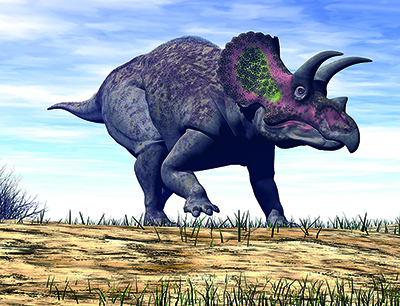
In the most recent Jurassic Park movie, dinosaurs are portrayed as warm-blooded animals frolicking in cold, snowy environments.1 At one point in the film, a large feathered raptor-like theropod even dives into an ice-covered lake and swims around. This idea comes not from the facts of science but rather from the evolutionary myth that warm-blooded birds supposedly evolved from dinosaurs. Could dinosaurs have also been warm-blooded?
Today’s reptiles are cold-blooded, which means their body temperature varies according to the temperature of their environment. This is why many reptiles live only in warm climates. Those who live in colder climates are only active during the warm season and hibernate in the winter. Since dinosaurs are extinct, how can we tell whether they were cold-blooded? As it turns out, a variety of tell-tale anatomical features preserved in their fossil remains give us the answer.
The first piece of evidence comes from the skulls of several dinosaurs, including tyrannosaurs, indicating that their nasal passages were too narrow to be warm-blooded.19 This matches the anatomy of today’s crocodiles. Most importantly, these dinosaurs lacked turbinates, complex respiratory structures that 99% of warm-blooded animals such as mammals and birds possess. Turbinates are specialized features inside the nose that heat and humidify air as it passes through the nasal cavity and into the lungs.19 Because of the narrow nasal passages and lack of turbinates, reptiles couldn’t have lived in cold environments because their body temperature would plummet. The Jurassic Park movie depiction of dinosaurs living in snow and cold is pure fiction.
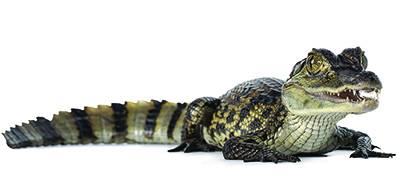
Dinosaurs have other diagnostic features similar to living reptiles that indicate cold-bloodedness. In the abdominal cavity of a theropod dinosaur, researchers discovered fossilized soft tissue that revealed a lung ventilation system like that of crocodiles.19 In another study, researchers analyzed the skulls of a T. rex dinosaur and living alligators.20 Similar to a T. rex, alligators have two large holes on top of their skulls. In alligators, these holes are filled with specialized blood vessels and thermoregulatory tissues. Thermal imaging showed that the tissues in these holes metabolically fluctuated with external temperature.
The researchers deduced that this was part of a crosscurrent circulatory system associated with an internal thermostat. Until this study, scientists had erroneously assumed that these same spaces in dinosaur skulls contained jaw muscles. Given that dinosaur brains are similar in shape and structure to the brains of living reptiles like alligators, this new finding comes as no surprise.21
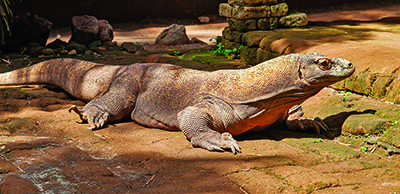
So, if dinosaurs were cold-blooded, how did they hunt down prey or avoid becoming prey? Answers to this question come from studying the Komodo dragon, a living large-bodied reptile.22 Komodo dragons are able to rapidly ramp up their metabolism to near-mammalian levels for incredible bursts of speed and even extended arduous sprints. When researchers sequenced the Komodo dragon genome and compared its various metabolic genes known to be common among reptiles, they discovered genetic evidence associated with this metabolic ability.
Based on their findings, researchers proposed that many dinosaurs had low metabolic levels during resting or low-activity periods but could rapidly expand their lung ventilation levels for bursts of activity associated with running, attacking, and defensive maneuvers. This metabolic trait would have also allowed large dinosaurs to sustain life within a reasonable level of caloric intake. Indeed, research has shown that if large dinosaurs were warm-blooded, they wouldn’t have been able to ingest enough food to maintain their metabolism.20,22
Myth Three: Dinosaurs Had Feathers
The third evolutionary dinosaur myth is that a variety of dinosaurs had feathers or protofeathers, sometimes called dino fuzz. This claim is often used to undergird the paradigm that dinosaurs evolved into birds. But before we start putting feathers on dinosaurs, we have to ask how they could preen feathers.23 Birds spend a lot of time fixing their feathers so they are functional, penguins included. Without a bird’s beak, how could the dinosaurs maintain feathers? Instead, modern paleontologists are so convinced that birds are dinosaurs and vice versa that they don’t even consider this issue.
The main problem with the dinosaur feather idea is that it has no strong support from research in the field. Alan Feduccia, an evolutionary bird paleontologist, has published several papers and books that show dinosaurs didn’t have dino fuzz—or even feathers, for that matter.23,24 He showed in a 2005 study that so-called dino fuzz was merely the fossil remains of thin collagen fibers left over from partially decomposed skin.23 The research included analysis of decomposing collagen skin fibers in reptiles, sharks, and dolphins, and comparisons of these fibers with those of several dinosaurs.
Feduccia has also debunked most of the claimed feathered dinosaurs as merely boney-tailed birds with feathers, like Archaeopteryx, one of the earliest birds found in Flood rocks.19 In fact, Archaeopteryx is found in Flood rocks well below the claimed bird-like dinosaurs.21 How can the descendants appear in the rock record before their claimed ancestors?
Again, unchecked evolutionary speculation is the answer. Mainstream paleontologists claim there was an unknown ancestor in the rocks below both Archaeopteryx and the bird-like dinosaurs. They call these “ghost lineages.” The problem is that these ghost fossils don’t exist and have never been found. It’s all imagination! The rocks tell us there were true birds buried in Flood rocks before Velociraptor appeared. There was never any evolution from dinosaurs to birds, period.
Myth Four: Dinosaurs Had Bird Brains
Because of paleontologists’ blind acceptance that dinosaurs are essentially birds, it’s no surprise that dinosaurs are often portrayed as being exceptionally intelligent. The problem with this line of reasoning is that dinosaur brains were similar in shape to alligator or crocodile brains and about the size equivalent of scaled-up reptiles living today.21,23 They didn’t have the shape of bird brains or the relative brain volume.
Admittedly, Velociraptor-style theropods had bigger brains than most dinosaurs, but they weren’t large enough to be a bird’s. So, they didn’t have the bird-like intelligence that Jurassic Park portrays.
Conclusion
The scientific evidence strongly shows that all the different kinds of dinosaurs appeared suddenly in the rock record without any previous ancestors. Their fossils, which still contain soft tissue and biomolecules, speak directly to their being buried in the global Flood about 4,500 years ago.
Also, dinosaur anatomy and morphology compare favorably with that of living reptiles, showing they were most likely cold-blooded. And the lack of evidence for feathers, combined with reptile-shaped brains, demolishes the claims of bird evolution. This negation of dinosaur-bird evolution is further bolstered by the fact that birds appear in the rock record before raptor-like dinosaurs, the supposed precursors to birds.
Despite the fanciful depictions in Jurassic Park movies, the evidence shows that dinosaurs were created as dinosaurs, just as Genesis says, and their fossilized remains were buried in the global Flood around 4,500 years ago.
References
- Clarey, T. Imaginary Dinosaur Science in Jurassic World: Dominion. Creation Science Update. Posted on ICR.org June 20, 2022, accessed June 23, 2022.
- Tomkins, J. T. 2019. Six Biological Evidences for a Young Earth. Acts & Facts. 48 (5): 10-12.
- Tomkins, J. T. 2021. The Fossils Still Say No: Tumultuous Triassic Tussle. Acts & Facts. 50 (7): 10-12.
- Clarey, T. 2020. Carved in Stone: Geological Evidence of the Worldwide Flood. Dallas, TX: Institute for Creation Research.
- Tomkins, J. P. 2020. The Fossils Still Say No: The Cambrian Explosion. Acts & Facts. 49 (12): 10-13.
- Tomkins, J. P. 2021. The Fossils Still Say No: The Origin of Vertebrates. Acts & Facts. 50 (1): 10-12.
- Tomkins, J. P. 2021. The Fossils Still Say No: The Mystery of Jawed Vertebrates. Acts & Facts. 50 (2): 12-14.
- Tomkins, J. P. 2021. The Fossils Still Say No: The Fins-to-Feet Transition. Acts & Facts. 50 (3): 10-13.
- Tomkins, J. P. 2021. The Fossils Still Say No: Missing Early Evolution of Land Vertebrates. Acts & Facts. 50 (4): 10-12.
- Tomkins, J. P. 2021. The Fossils Still Say No: Enigma of the Carboniferous Explosion. Acts & Facts. 50 (5): 11-13.
- Tomkins, J. T. 2021. The Fossils Still Say No: Global Flood Solves Permian Perplexities. Acts & Facts. 50 (6): 10-12.
- Tomkins, J. P. 2021. The Fossils Still Say No: Jostle in the Jurassic. Acts & Facts. 50 (8): 10-12.
- Tomkins, J. P. 2021. The Fossils Still Say No: Capping a Cretaceous Conundrum. Acts & Facts. 50 (9): 8-11.
- Schweitzer, M. H. et al. 2005. Soft-Tissue Vessels and Cellular Preservation in Tyrannosaurus rex. Science. 307 (5717): 1952-1955.
- Schweitzer, M. H., J. L. Wittmeyer, and J. R. Horner. 2007. Soft tissue and cellular preservation in vertebrate skeletal elements from the Cretaceous to the present. Proceedings of the Royal Society B. 274 (1607): 183-197.
- Schweitzer, M. H. et al. 2009. Bimolecular Characterization and Protein Sequences of the Campanian Hadrosaur B. canadensis. Science. 324 (5927): 626-631.
- Armitage, M. H. and K. L. Anderson. 2013. Soft sheets of fibrillar bone from a fossil of the supraorbital horn of the dinosaur Triceratops horridus. Acta Histochemica. 115 (6): 603-608.
- Thomas, B. 2022. List of Biomaterial Fossil Papers. Posted on Google Docs.
- Clarey, T. 2016. Dinosaurs Designed Cold-Blooded. Acts & Facts. 45 (1): 15.
- Tomkins, J. P. and T. Clarey. 2019. Dinosaurs Had Reptilian Metabolic Adaptation. Acts & Facts. 48 (12): 14.
- Clarey, T. 2015. Dinosaurs: Marvels of God’s Design. Green Forest, AR: Master Books.
- Tomkins, J. P. Komodo Dragon Genome Bites Evolution. Creation Science Update. Posted on ICR.org September 10, 2019, accessed June 23, 2022.
- Feduccia, A., T. Lingham-Soliar, and J. R. Hinchliffe. 2005. Do Feathered Dinosaurs Exist? Testing the Hypothesis on Neontological and Paleontological Evidence. Journal of Morphology. 266 (2): 125-166.
- Feduccia, A. 2020. Romancing the Birds and Dinosaurs: Forays in Postmodern Paleontology. Irvine, CA: Brown Walker Press.
* Dr. Tomkins is Director of Research and Dr. Clarey is Research Scientist at the Institute for Creation Research. Dr. Tomkins earned his Ph.D. in genetics from Clemson University, and Dr. Clarey earned his Ph.D. in geology from Western Michigan University.





